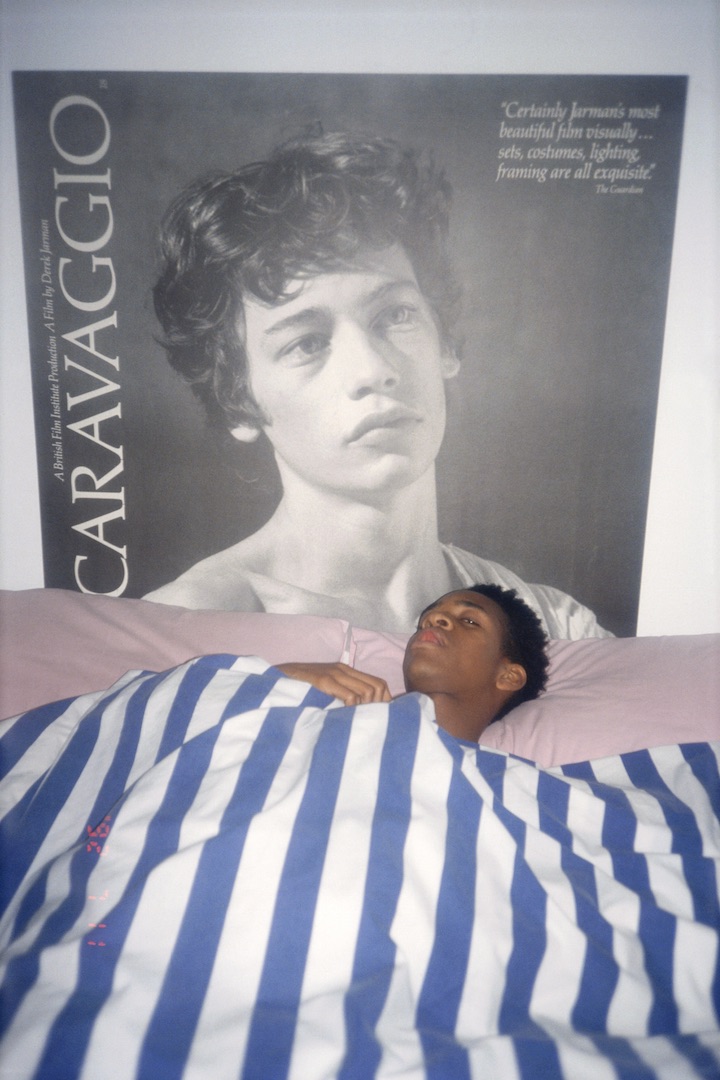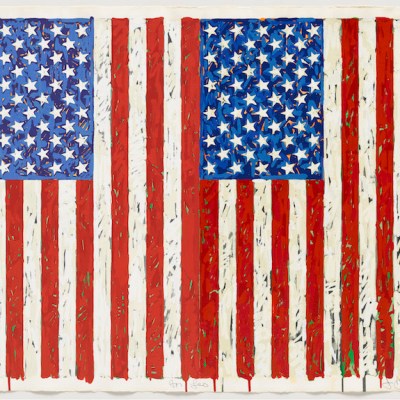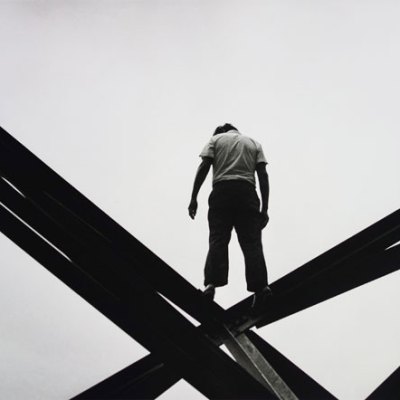The final segment of Kamasi Washington’s Harmony of Difference (2017) – which blends music, film and painting in a six-part ‘performance’ – opens with the image of a cosmic haze, before cutting to the interior of a modest domestic space. There, a black boy pools water in his cupped hands, then splashes it across his face. In the musician’s debut gallery work, commissioned for the Whitney Biennial, an ascendant musical score accompanies a film montage (directed by A. G. Rojas) that pays homage to themes of family and spirituality in black and Chicanx communities. In one visually stunning and recurring scene, two men wrestle, their bodies locked in elegant embrace, within a field of pink flowers, recalling the Castilian roses of the Virgin of Guadalupe. Later, we see the boy gaze again into his hands, and the entire galaxy is held within his grasp.
As most readers are likely aware, public discussion about this edition of the Whitney Biennial has centred on the escalating controversy surrounding Dana Schutz’s painting Open Casket (2016), which depicts and problematically abstracts the body of Emmett Till, a 14-year-old black boy who was murdered in 1955 at the hands of a white mob. Protesters have called for its removal and destruction, questioning whether Schutz, a white artist, has a claim to this story, and whether her gaze re-enacts something of its original violence. The incident has launched a productive dialogue around the stakes of representation and the persistence of ‘afropessimism’ in art and the media, whereby mainstream narratives about blackness continue to focus on, and even fetishise, violence and disenfranchisement, to the exclusion of other themes. Some commentators seeking to unpack the role of the artist’s racial identity have invoked the painting of Philando Castile, also on view, by Henry Taylor (a black artist). The comparison is apt, yet still aligns African American experience with death.
Installation view of Harmony of Difference (2017), Kasami Washington. Photograph: Bill Orcutt, collection of the artist

Harmony of Difference is installed in the gallery adjacent to Open Casket, and to borrow Washington’s own term, this and other works by black artists in the biennial offer compelling counterpoints to the narrative that Schutz engages. In music, ‘counterpoint’ implies the juxtaposition and merging of different melodies in a single piece, which Washington employs as a metaphor for the positive effects of diversity. The first five filmic ‘movements’ in his work (titled ‘Desire,’ ‘Humility,’ ‘Knowledge,’ ‘Perspective,’ and ‘Integrity’) record the surfaces of paintings by the artist’s sister. They are shown on three wall-mounted screens, and ultimately combined in the first half of ‘Truth’ (the final movement) in a single balanced composition. Each pattern of brushstrokes maintains its individual character, yet collectively they enhance the whole. Finally the abovementioned film commences, projected onto a fourth wall, and concluding the piece.
The debates surrounding Open Casket have been crucial in drawing attention to Till’s story and the ethics of representing violence. But we also stand to learn much from works by other artists, which take a more holistic and affirmative approach to black history and experience. These counterpoints are all the more pressing as the debacle has ultimately foregrounded a white artist’s perspective on these issues.
Lyle Ashton Harris’s Once (Now) Again (2017), for instance, presents the artist’s photographic archives from the 1980s–90s, chronicling his participation in the art world and the gay and black communities. Often, these various trajectories intersect: one slide features a nude white man standing, statuesque, in a dark room; a Mitra Tabrizian photograph from the 1980s is faintly visible behind him. Viewers may spot the likenesses of public figures such as Stuart Hall, Thelma Golden or Paul Gilroy, but also portraits of anonymous friends and lovers – dressed up, undressed, and in drag – and views of cluttered bedrooms and city parks. Importantly, the installation lends visibility and nuance to the black queer experience, especially during those fraught years marked by identity politics, broken-windows policing and AIDS activism.
Lyle, London, 1992 (2015), Lyle Ashton Harris. Courtesy the artist

Cauleen Smith’s hand-stitched banners, collectively titled In the Wake (2017), respond to the fatigue of internalising and confronting racism in America. ‘We were never meant to survive,’ one professes. Symbols like a microphone and pencil, on another, signal the necessity of telling one’s own stories, another powerful counterpoint to Open Casket. This mandate is fulfilled elsewhere in several locally-grounded works by artists of varied backgrounds, including Deana Lawson’s enigmatic photographs of black homes and Oto Gillen’s haptic explorations of New York. Celeste Dupuy-Spencer’s cartoonish renderings of a Trump rally or an art collector’s home offer pointed critiques of whiteness in America. Likewise, Maya Stovall’s Liquor Store Theatre presents what the artist calls a ‘dance ethnography’ of east Detroit, and features interviews with long-term residents of the McDougall-Hunt neighbourhood that touch on gentrification and blight, but also resilience and belonging. Stovall characterises the liquor store as a kind of ‘backstage view of ongoing life…in spite of narratives of abandonment.’
Installation view of In the Wake (2017), Cauleen Smith. Collection of the artist; courtesy Corbett vs Dempsey, Chicago and Kate Werble Gallery, NY

Many of these examples are traditionally representational: interestingly, much of the discussion about Open Casket has hinged on the appropriateness of Schutz’s characteristically grotesque painterly style, and on the limitations of abstraction or figuration in political art. Indeed, throughout the biennial at large, there is a tension between those works that engage with formalism or fantasy (KAYA, Kaari Upson, Anicka Yi), and those that employ the aesthetics of research or realism (Pope.L, Occupy Museums, Jordan Wolfson). Ultimately, all 63 artists featured confront the widespread anxiety that defines this historic moment. Presenting a mélange of American perspectives, the biennial succeeds in keeping a finger on the pulse of a divisive and diverse cultural landscape.
The Whitney Biennial 2017 is at the Whitney Museum of American Art, New York, until 11 June.



